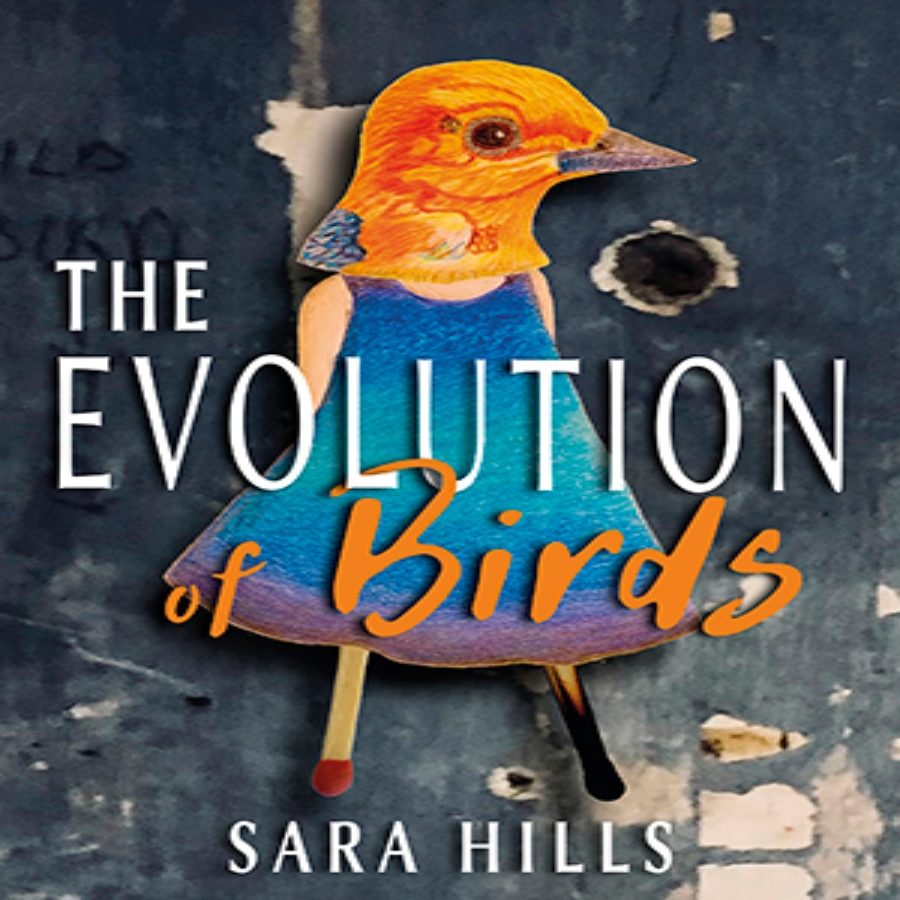
Golden, Blazing Words: A Review of The Evolution of Birds
Sara Hills’ debut flash collection The Evolution of Birds brings her unique brand of surreality to birds, humans and the evolution of both with a skillful blurring of humanity and reality. From dark moments to humor, the collection brings Hills’ unique voice in layers, unflinching, but also balanced with endearing moments and wry humor.
The collection of 48 flashes and micros are an evolutionary entry in flash fiction. Nearly half (nineteen of the forty-eight) of the flashes are unpublished, unread and awaiting readers to discover them as literary wonders, akin to opening a tomb of golden feathered humans and golden feathered birds.
Publisher Ad Hoc brings Hills’ collection to life with a practiced eye, introducing yet another stellar flash volume in their ever-expanding lineup. A family project, Hills’ daughter creates the stunning artwork to evoke the title and so much more, giving us a visual peek into another mother/daughter relationship.
The title flash “The Evolution of Birds” starts off the evolutionary table of contents of girls, birds, nuns, hippos and tigers, IKEA and Survival Camp. Hills does more than write words, she intentionally blazes them across pages. In the opening salvo across the ornithology bow, we get a momentary hint of lightness with the main character’s name: “Hope.” Hills infuses the opener with words that foreshadow and just plain shadow: pointed sticks, fire, bow drill, a lean-to, foragers cobbled-together.
“Hope was the first girl to whittle an arrow and erect a lean-to with foraged brush; the first and only one to get the fire started by means of a cobbled-together bow drill—a strung-up stick whirled fast and hot in the shallow groove of a wooden plate.”
The opening story is part of Hope’s origin story, part collection origin story but also begins a coming-of-age for the entire collection. Hills continues on to move characters through evolutions of spirit, life, relationships, religion and grief: immersing the reader with sensual details: charred grease, sleek grey bodies, an iridescent flash of purple, red outlines of bird bodies, throated coos, silver birch and sycamore, rusted red under fingernails, pink flesh on tin plates, wax-covered candy, dirt-flavored, molars dark packed in chocolate. The reader gets these flashes in flash of how humans and birds are existing and not-existing together.
There are evolutionary threads throughout the collection, themes that tie the stories together but also literal threads: a knitting hippo’s yarn, a baby’s ragged lifeline, umbilical cords from author to book to reader. Readers may find themselves tying their own lives to the stories while holding on to this evolution of girls, birds and humans. In “Finders Keepers”, the ending line sums up that movement from character to character, reality cast aside.
“You knot one end of the fraying mud-brown twine and put it where your heart used to be. The other end you hand to the baby, just in case.”
While each flash and micro has its own characters and settings through Hills’ skillful worldbuilding, the entire collection becomes a world in itself. In the opening story, the leader of the Survival Camp gives the campers instructions on how to survive. But, we also get instructions as exterior readers of the stories in his statements. Through Hills’ flashes and micros, we not only get inside the bird’s head, we also get inside each character’s head.
“Get inside the bird’s head,” the leader told us. “Think its thoughts—if it has any. Predict its responses. Detect the slightest effort to flee.”
The themes and settings here are familiar: shopping in an IKEA, threatening roads, coming-of-age, danger, girls, babies, fathers, mothers, nature, religion and yet, the storytelling is all Hills’ signature style.
While there are more ordinary words and phrases in the collection, Hills’ excels with unique and visual descriptions. A copse of silvery pines. An avalanche of wind, Tongue flakes with ice. Gum wrappers folded into a siren’s window pinwheels. The characters, sentences, phrases become an evolution in themselves, sparkling clues left behind. Whether the reader is in an IKEA tracking a rogue nun or telling stories to distract a sibling, Hills leaves hieroglyphs for reader archaeologists to discover — bits of fossil truths to dig through, excavate, process through emotion and empathy and evocativeness.
Hills brings readers familiar images that tug at emotions. An untethered child. Fraying life. Fraying twine. A heartbroken and missing and hurt. But there is also a hope thread that runs through the grief, loss, and pain of the flash grouping. The opening character Hope functions as a bellwether for the collection by refusing to eat the eventually-captured birds. Her reasoning is that she can’t eat the meat because she “knew the evolution of birds.” As readers, Hills guides us to explore the evolution of birds and humans and life.
For over 100 pages, each flash of The Evolution of Birds, readers see that despite difficult situations, there is survival and resilience. The existence of these stories together is the proof — the evolution. The survival. Hope/hope survives. The narrator survives. The Survival Camp campers survive. Readers will survive. Hills’ collection helps readers feel as if they might survive, thrive, move past grief and difficult childhoods and painful adulthoods, and maybe even sprout feathers and fly.
Amy Barnes has words at a variety of sites including The New Southern Fugitives, FlashBack Fiction, Popshot Quarterly, Flash Fiction Magazine, X-Ray Lit, Anti-Heroin Chic, Museum of Americana, Penny Fiction, Re-side, The Molotov Cocktail, Lucent Dreaming, Lunate Fiction, Rejection Lit, Perhappened, Cabinet of Heed, Spartan Lit, National Flash Flood Day and others. Her work has been long-listed at Reflex Press (3rd place, Summer 2020), Bath Flash Fiction, Retreat West, and TSS Publishing. She volunteers at Fractured Lit, CRAFT, Taco Bell Quarterly, Retreat West, NFFD, The MacGuffin, and Narratively. Her flash collection Mother Figures will be published in May 2021 by ELJ Editions, Ltd.
Submit Your Stories
Always free. Always open. Professional rates.
